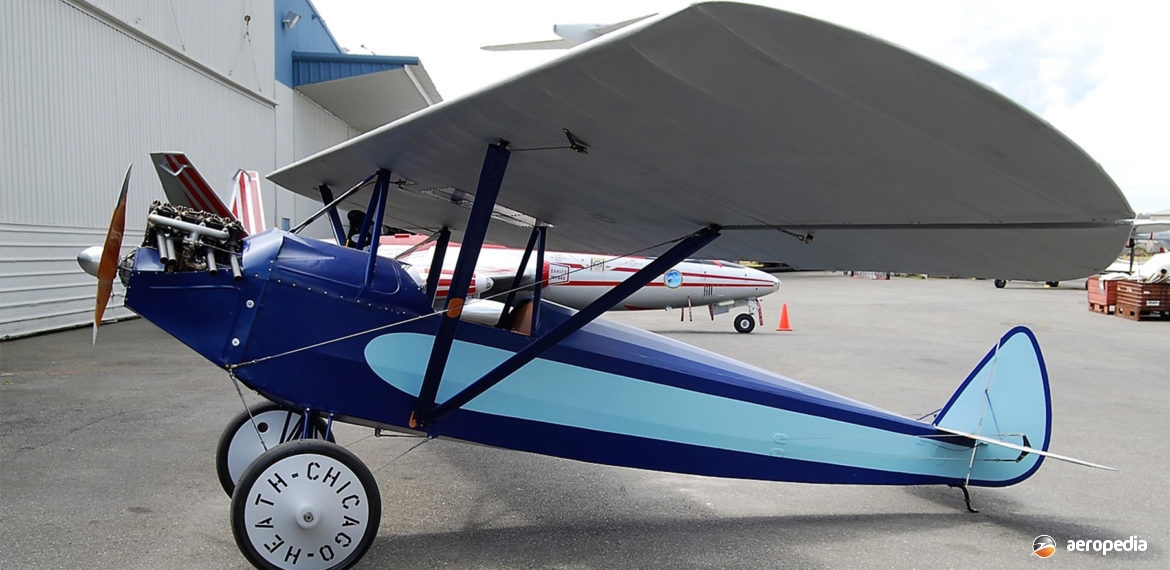Photograph:
Heath Parasol at Seattle, Washington, USA in July 2007 (David C Eyre)
Country of origin:
United States of America
Description:
Single-seat light amateur-built aircraft
Power Plant:
One 20 kw (27 hp) converted Henderson four-cylinder motor-cycle engine
Specifications:
- Wingspan: 7.6 m (25 ft)
- Length: 5.1 m (16 ft 9 in)
- Height: 1.8 m (5 ft 10 in)
- Wing area: 11.15 m² (120 sq ft)
- Max speed: 117 km/h (73 mph)
- Cruising speed: 100 km/h (62 mph)
- Rate of climb: 152 m/min (500 ft/min)
- Landing speed: 45 km/h (28 mph)
- Service ceiling: 3,353 m (11,000 ft)
- Range: 531 km (330 miles)
- Empty weight: 118 kg (260 lb)
- Loaded weight: 254 kg (560 lb)
History:
The Heath Parasol was designed in 1925 in Chicago, Illinois, USA, by Edward B Heath as an ultralight aircraft suitable for amateur construction. During the 1920s and early 1930s, when amateur-built aircraft were at the peak of popularity, the Parasol was the undisputed favourite in the USA. Hundreds were built and flown. Heath had flown his first aircraft in 1909 in New York State, and he established the Heath Aircraft Company to build propellers and other aviation supplies.
After World War I Mr Heath designed and built a number of small aircraft for racing, but his most successful aircraft was the Parasol, for which he originally used the lower-wing panels from a Thomas Morse Scout. Several variants of the Parasol were built. The first model, known as the Heath Super Parasol, was built from 1927 to 1930. In 1931 the Model V, with the wing struts coming together at the fuselage to form a ‘V’, was introduced. Most of the Model Vs had a welded steel tube fuselage, whereas the old Super Parasol used a tube, wire and rivet fuselage.
In February 1931 Heath was killed whilst flying a new design, but the company continued on for a few years. Variants in later years have been fitted with converted Volkswagen engines.
A number of Parasols were built in Australia and a couple have survived. The fuselage of one has been held in the collection of the Moorabbin Aircraft Museum, VIC. Another is known to be at Parafield, SA. Others have been in the collections of the Air Force Association Museum in Perth, WA and the Camden Museum of Aviation at Narellan, NSW. The construction of the Perth machine commenced in the early 1930s using drawings from the ‘Popular Aviation’ magazine.
One Parasol has been registered under Recreational Aviation Australia (RAA) Regulations as 10-0412 (c/n 003) and has been known as a Monarch Mengerson Heath Parasol or a Tweed Airtech Heath Parasol Monarch. The fuselage and mainplanes, etc, were completed and covered with fabric, but the aircraft was stored for a number of years. In 1958 the partly completed machine was given to the Ultra-Light Aircraft Association of WA but, due to Department of Civil Aviation (DCA as it then was) restrictions on the type, it was not completed and was stored at Maylands aerodrome. Fitted with a Volkswagen engine, approval was given in 1961 for the aircraft to be completed and flown.
However, because some liberties had been taken in construction, such as a shorter wingspan of 7.6 m (25 ft) instead of 9.45 m (31 ft), it could not be determined which variant it was, ie an LNB-4 Parasol, a Super Parasol, a Peterson Sportster, or a Parasol V, the latter being the most likely. It is believed the aircraft was completed some time in 1963 and was flown from country airstrips a number of times. No Certificate of Airworthiness was issued.
On 23 December 1964 it was flown from Maylands to Jandakot in Western Australia, and on 26 December from Jandakot to Kellerberrin where it was grounded. In 1965 attempts were made to bring the machine up to airworthiness standards but this was not achieved. In January 1978 restoration to display standard was completed and the aircraft was placed on display.
A few Examples of the Heath Parasol have been built in New Zealand and one received the registration ZK-ACW (c/n 1) but it has not survived.
A variant of the Heath Parasol, described as a monoplane, was promoted in April 1932 by the Adcock Aviation Company of Gosford, NSW. This aircraft was to be known as the Model SF and was fitted with a Continental A40 engine. It does not appear to have entered production.
Another Heath Parasol was built at the Methodist Mission on Millingimbi Island, NT in 1933 by H U Shepherdson. This machine had a 25 kw (34 hp) Bristol Cherub engine driving a four-blade propeller. It took two years to complete and made a few short flights but was damaged when it hit a tree stump whilst taxiing.

